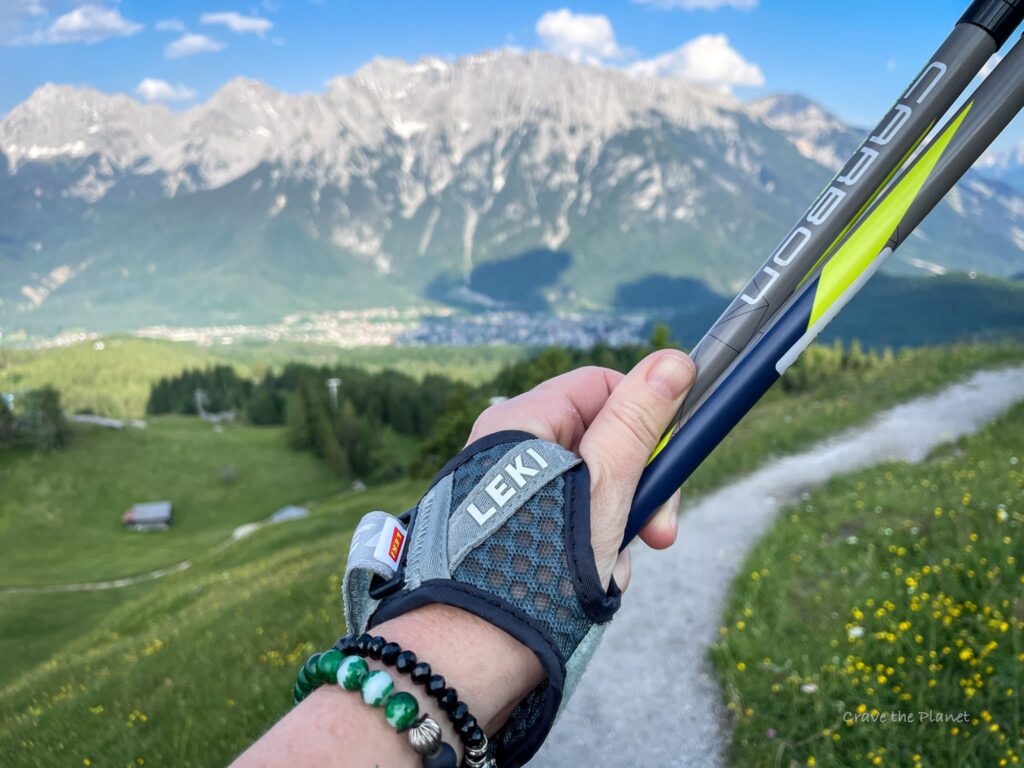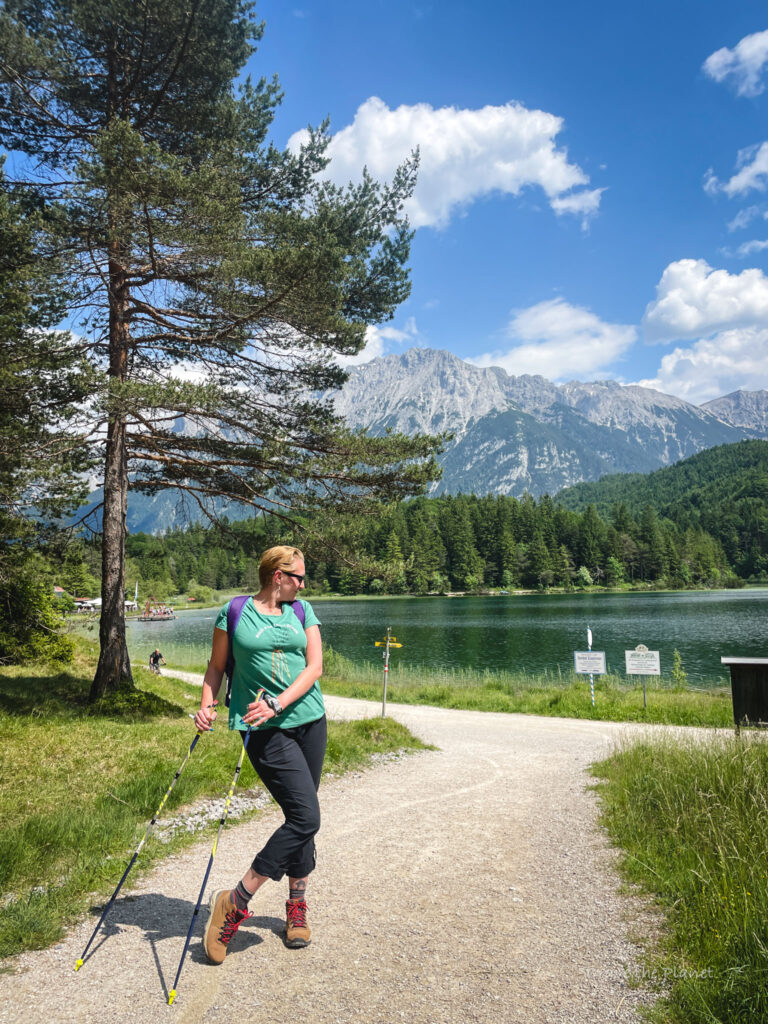
Benefits of Trekking Poles (and cons)
Trekking poles, also known as hiking poles, are a pair of sticks used to provide extra support and stability while hiking or walking on rough terrain.
They are made of lightweight materials like aluminum or carbon fiber, and come in both adjustable and fixed-length designs. Some poles are even foldable, making them easier to pack and carry during your hike.
Morgan’s Trekking Poles Pros and Cons Youtube
7 Benefits of Trekking Poles

Trekking poles can offer a wide range of benefits to hikers of all levels. Here are some of the key benefits of using trekking poles while hiking:
1. Improved Stability and Balance
Trekking poles can help you maintain better stability and balance while hiking. By using trekking poles, you can reduce the risk of slipping, tripping, or falling while traversing uneven terrain. They provide additional points of contact with the ground, which can make it easier to maintain your footing.
2. Increased Support and Shock Absorption
Trekking poles can also help reduce the impact of hiking on your joints. They can absorb some of the shock that would otherwise be transferred to your legs and feet, which can help reduce the risk of injury and fatigue. This can be especially beneficial on long hikes or when carrying a heavy backpack.
Read ➡️ How to Use Trekking Poles
3. Enhanced Comfort and Confidence
Using trekking poles can also increase your overall comfort while hiking. They can help you maintain an upright posture, which can reduce strain on your back and neck. Additionally, they can help you feel more confident while hiking, which can make the experience more enjoyable.
4. Improved Fitness and Endurance
Trekking poles can also provide a workout for your upper body. By using your arms to help propel yourself forward, you can increase your overall fitness and endurance. This can be especially beneficial for hikers who want to challenge themselves and improve their physical fitness.
Some reports state a 20% extra calorie burn from using trekking poles. This often is a benefit.
Trekking Poles and Terrain Navigation

Trekking poles can be a valuable tool when navigating various terrains. Whether you are hiking uphill or downhill, crossing rivers or streams, or encountering difficult terrain or obstacles, trekking poles can provide added stability and support.
5. Distribute Weight Evenly
When hiking uphill, trekking poles can help distribute your weight more evenly and reduce the strain on your legs. You can also use the poles to push yourself up the hill and maintain your momentum. When hiking downhill, trekking poles can help reduce the impact on your knees and provide added stability on uneven terrain.
6. Crossing Streams Safely
When crossing rivers or streams, trekking poles can provide added stability and help you maintain your balance. You can use the poles to test the depth of the water and to help you navigate slippery rocks or other obstacles.
In difficult terrain or when encountering obstacles, trekking poles can provide added support and help you maintain your balance. You can use the poles to help you climb over rocks or other obstacles, or to help you navigate steep or uneven terrain.
7. Improved Traction
When it comes to traction, trekking poles can be especially useful in slippery or muddy conditions. You can use the poles to help you maintain your footing and prevent slips and falls.
BONUS: Less Pain on the Downhills.
Read ➡️ Best Trekking Poles for Hiking
Pros of Trekking Poles

Trekking poles can be a valuable addition to your hiking gear, providing a range of benefits.
- Perception: “Feel” Safer
- They can help improve your balance and stability
- reduce the impact on your knees and joints
When choosing trekking poles, there are a few things to consider.
Adjustable vs Fixed Length
Adjustable poles allow you to change the length to suit your height and the terrain you’re hiking on.
Fixed-length poles are lighter and more durable, but may not be as versatile.
Foldable poles are great for backpackers who need to save space, but may not be as sturdy as other designs.
The material of your trekking poles is also important. Aluminum poles are strong and durable, but heavier than carbon fiber poles. Carbon fiber poles are lightweight and strong, but may be more expensive. Choose a material that suits your needs and budget.
Standard trekking poles typically have a simple design with a rubber or cork handle and a carbide tip for grip. Some poles come with additional features like shock absorption, anti-slip grips, and interchangeable baskets for different types of terrain.
❤️ YOUR FEET!!!! LEARN ALL MY BEST EXPERT TIPS AND TRICKS TO CARE FOR YOUR FEET WHILE HIKING
- Best Hiking Socks for Preventing Blisters
- How to Hike with Plantar Fasciitis
- How to Protect Your Toes Downhill Hiking
- Review of the Best Blister Kits for Hiking
- Injinji Socks Review
Learn from my almost 3 decades of hiking, running and physical therapy practice.
We hope this guide filled with interesting information about the benefits of trekking poles has given you the proper information to plan your next adventure.
More Resources
Discover gear that elevates your outdoor adventures. As a physical therapist, I’ve curated product comparisons to enhance safety and enjoyment, perfect for beginners or those with weary knees.
Physical Therapist Curated Gear Guides for Hikers & Skiers
- 🧎 Make your knees feel better while hiking and walking: Best Knee Braces for Hiking
- 🌳Make the downhills stop hurting and hike with more confidence Best Trekking Poles Review
- ⌚ Never get lost on the trail and navigate the wilderness safely with My Review of the Best GPS Watches for Hiking
- ❄️ Go hiking on uneven terrain safely: The Best Hiking Boots with Ankle Support
- Don’t get lost in the backcountry with : My Review of the Best 2 Way Radios for the Mountains
My Guides to Bucketlist Hikes in Europe
(That I’ve personally done and loved.)

Author profile: Morgan Fielder is a Doctor of Physical Therapy and passionate hiker who believes in exploring the world on foot with good food. Follow her journey as she shares science-based hiking tips and advocates for sustainable tourism.
